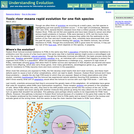
Read the Fine Print
Some Rights Reserved
Though we often think of evolution as occurring at a snail's pace, one fish species is highlighting just how quickly evolution occurs in the right circumstances. Between 1947 and 1976, General Electric released more than a million pounds of PCBs into the Hudson River. PCBs can kill fish and seabirds and have been linked to cancer and other serious health problems in humans. PCBs were banned in 1979, but the toxins have remained at high levels in the Hudson because they settle into the sediments on the bottom of the river and don't break down. Now, scientists have discovered that, over the past 60 years, one bottom-feeding fish species, the Atlantic tomcod, has evolved resistance to PCBs.
- Subject:
- Biology
- Life Science
- Material Type:
- Diagram/Illustration
- Reading
- Provider:
- University of California Museum of Paleontology
- Provider Set:
- Understanding Evolution
- Date Added:
- 03/01/2011